Zarda Rice (Sweet Yellow Rice) is a fragrant dessert with fruits, nuts and spices. Here’s a perfect recipe and easy-to-follow video for making this family-favourite South Asian sweet at home.
Learn how to make Zarda Rice (Sweet Yellow Rice) that’s:
- Simple to prepare
- Quick
- Easy to veganise
- Gluten-free option
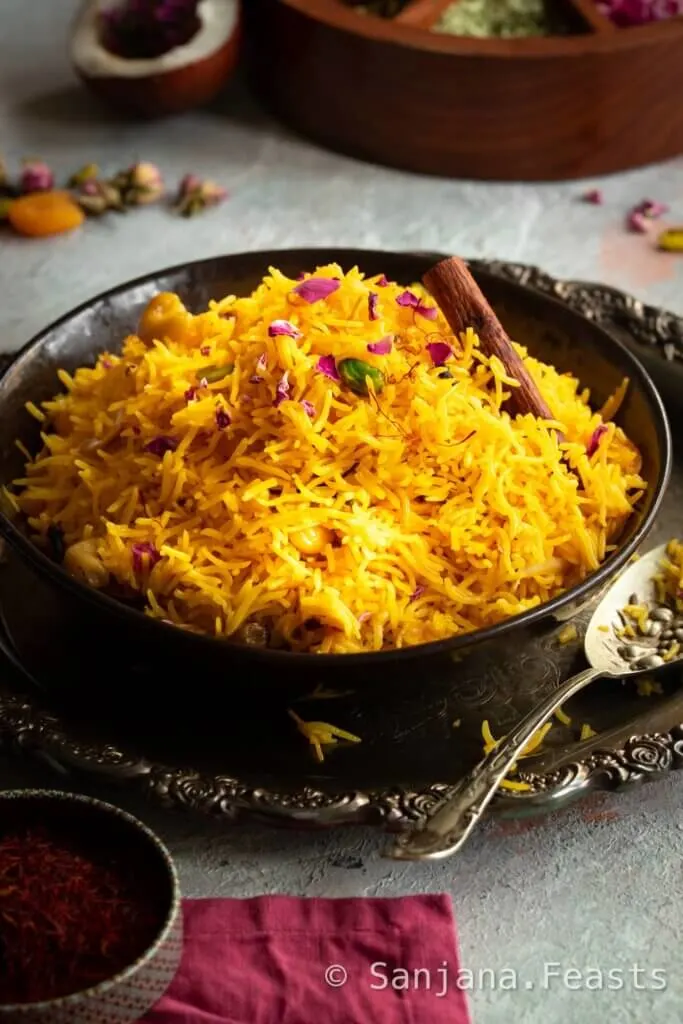
One of life’s greatest pleasures is cracking open a dough-sealed pot of rice and spices; One that’s been cooking in earthenware, under the pressure of its’ own steam. Pulao and biryani are prime examples of savoury dishes from the Indian subcontinent that adopt this ‘dum’ cooking technique. ‘Dum’ cooking simply translates as ‘warm breath’, for the ingredients in the pot cook unhurriedly, in gentle steam.
How to make the best Zarda rice at home
1. Wash and soak the rice
It’s imperative to first wash and soak the rice for 30 minutes prior to cooking Zarda rice.
2. Drain and toast the rice
Drain well. Toast the rice ghee to draw out every bit of fragrance. I add a handful of wheat vermicelli and nuts to intensify the warm, roasted flavours.
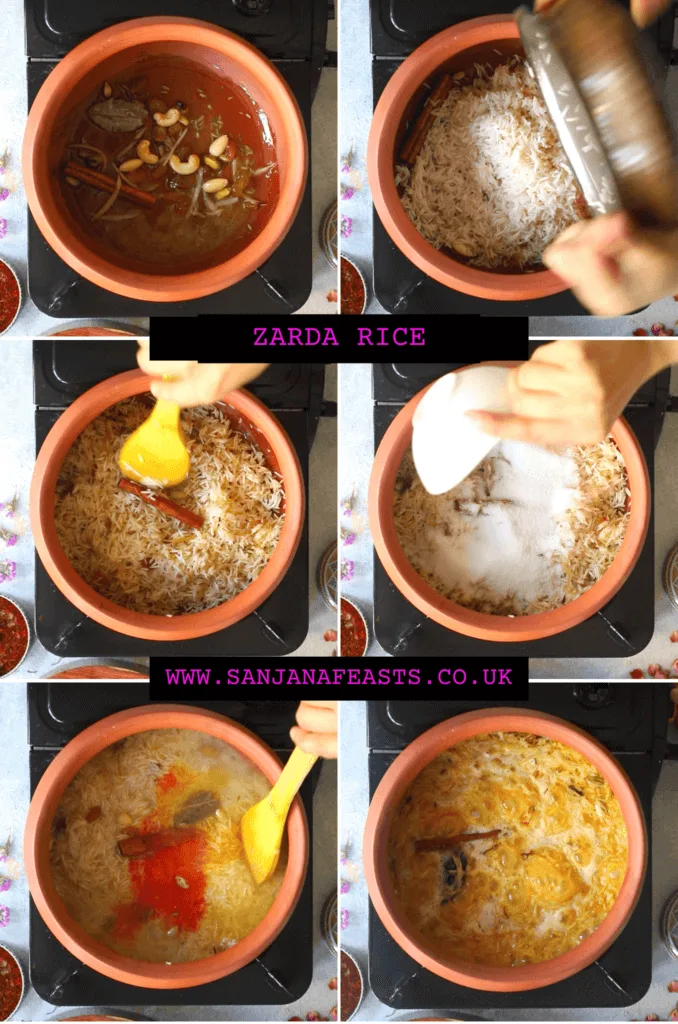
3. Don’t forget the whole spices!
A selection of whole spices like fennel seeds, cinnamon, cardamom, bay leaves and cloves infuse each and every grain while all the ingredients get acquainted in the pot. I often use a clay pot because the flavour of rice cooked in earthenware is an emotion in itself. Of course, any pot will do, but there is something very special about cooking in clay.
4. Cook on ‘dum’
Add water, along with sugar, kewra (pandan flower water) and saffron steeped in milk. This is where the beautiful golden yellow colour of Zarda steals the show. Bring it to a rolling boil for a few minutes before sealing the pot with a ring of dough and a lid. Turn the heat down to the lowest setting and allow the rice to finish cooking in its’ own steam. It’ll take no longer than six or seven minutes, since the rice was first soaked.

5. Leave it
After you’ve switched the heat off, it’s imperative, and I mean the actual law that you leave the pot sealed and undisturbed for at least 20 minutes. Don’t even think about cracking it open. Leave the Zarda to handle itself — it’s entirely capable, I promise.
As the steam builds up and subsides inside the pot, the grains of rice plump up and infuse slowly enough to keep them separate.

6. Crack the pot open
Finally, run a butter knife around the edge of the pot, crack open the lid and take a deep inhale, à la mindfulness meditation and savour the aromas of this perfectly-cooked Zarda. Pile mounds of it on to your plate.
What does ‘Zarda’ mean?
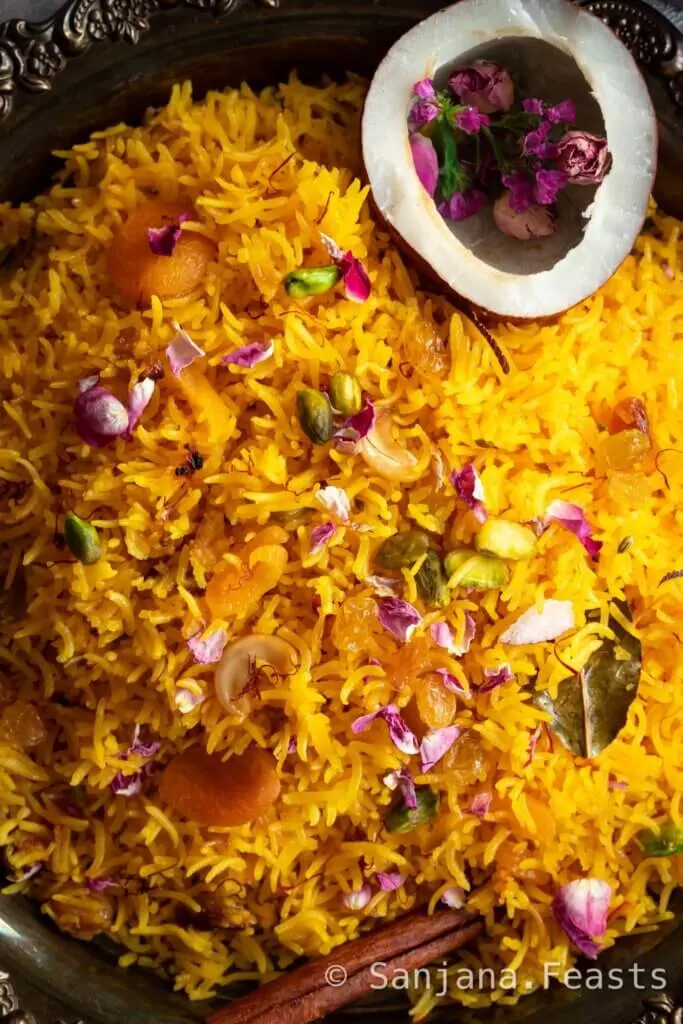
The name Zarda comes from Persian word ‘zard’ meaning ‘yellow’. Zarda is therefore named for its’ colour, since this family-favourite rice dish is a celebration of saffron (and often food colour). All the best South Asian desserts are, aren’t they?
Other names for Zarda include: zarda biryani, meethe chawal, zafrani zarda, zarda pulao, zorda, jarda and jorda. Mutanjan is a variation of Zarda which includes pieces of sweets like gulab jamun or sweet boondi. I include apricots and sultanas in my recipe. Candied fruits (murabba) like cherries, papaya and raisins can also be added.
More delicious desserts
What is the best rice for Zarda?
Any long-grain white basmati rice is ideal for making Zarda. The rice should be fragrant and fluffy.
How to make Zarda (Sweet Yellow Rice) with leftover rice
Yes, it’s possible! Simply cook the rice like any fried rice dish. The plain rice must be cooked and cold (make sure it’s not overly salted). There’s no need to toast the rice or cook it in water. Omit the vermicelli. Add all the whole spices to ghee and sauté the rice. Add sugar, saffron milk, kewra and chopped fruits and stir-fry for 3-4 minutes. Do not overcook or the sugar will begin to caramelise.
Can I make vegan Zarda?
The method for making vegan Zarda is super simple using this recipe. Simply replace the ghee with coconut oil or your favourite brand of commercial vegan butter and swap the milk for any dairy-free milk alternative, or water.
Gluten-free Zarda
To make this recipe for Zarda free from gluten, simply omit the wheat vermicelli.
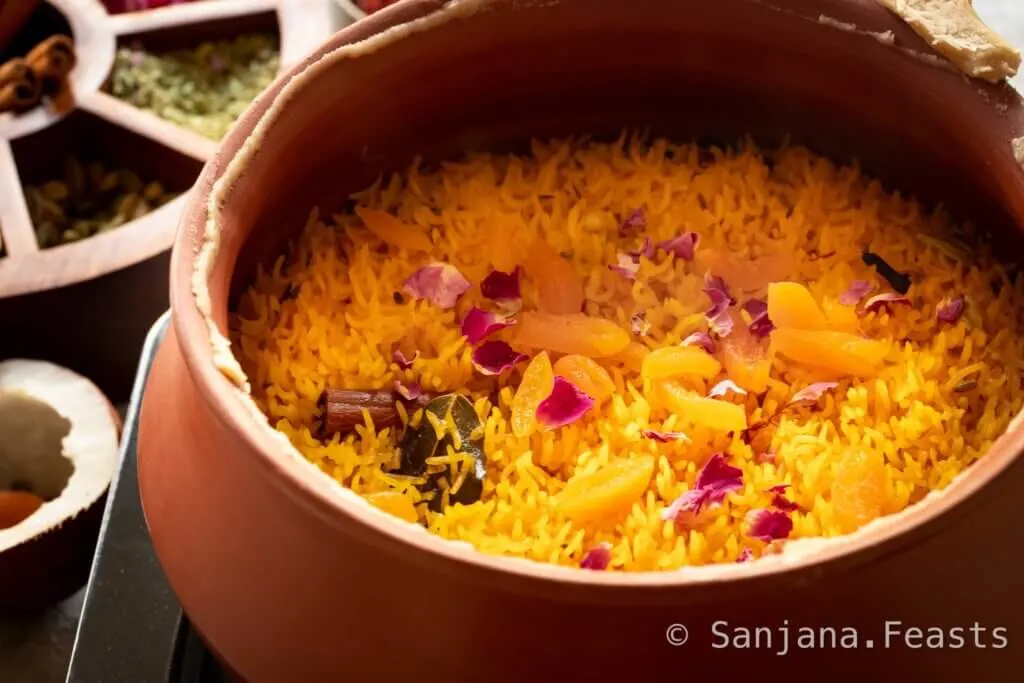
Some final tips for making Zarda
To make Mutanjan, garnish the rice with additional sweetmeats like Gulab Jamun and Sweet Boondi. You can also crumble Khoya (milk solids) on top of the cooked Zarda for a more elaborate and rich finish.
It’s often the case that at banquets and festivals, edible silver leaf (varkh) is placed on top of the Zarda for decoration. Feel free to do this. I skip it, since I usually reheat my Zarda in the microwave. If you plan on doing the same, remember to omit any edible metallic leaf.
To reheat Zarda rice in the microwave, place it in a microwave-safe bowl and cook on high power in 1 minute bursts, stirring in between until the rice is piping hot.
Zarda will keep well in an airtight container (refrigerated) for up to 3 days.
How to make Zarda Rice (Sweet Yellow Rice) in English | Recipe card | Printable Zarda Recipe
Zarda Rice (Sweet Yellow Rice)

Zarda Rice (Sweet Yellow Rice) is a fragrant dessert with fruits, nuts and spices. One of life's greatest pleasures is cracking open a dough-sealed pot of rice and spices; One that's been cooking in earthenware, under the pressure of its' own steam.
Ingredients
- 300g long-grain white basmati rice
- 85g ghee
- 2 tbsp sev (wheat flour vermicelli) - omit if gluten free
- 1/4 tsp fennel seeds
- 2.5cm stick cinnamon
- 3 cloves
- 4 green cardamom
- 1 dried bay leaf
- 6-7 strips fresh or dried coconut
- 2-3 cashews
- 2-3 almonds
- 2-3 pistachios
- 2 tbsp sultanas or raisins
- 150g white granulated sugar
- 600ml hot water
- Orange food colour
- Pinch of saffron soaked in 2 tbsp warm milk or water
- 1/2 tsp kewra water (screwpine/pandan flower extract) or rosewater
- 1/8 tsp salt
- Chopped apricots and dried edible rose petals (to garnish)
Instructions
- Wash the rice under running water for a few minutes, then soak for 30 minutes. Drain in a sieve for at least 10 minutes.
- Heat the ghee in a large pan (preferably one with a tight-fitting lid). Once melted, add the cinnamon, cloves, cardamom, fennel seeds, cashews, almonds, pistachios, sultanas, bay leaf and coconut shreds. Sauté for 90 seconds over a low heat.
- Add the vermicelli and continue to sauté until it turns a nutty, brown colour, about 60-90 seconds. Be sure to do this over a low heat.
- Tip in the soaked and drained rice and mix gently to coat each grain in ghee and spices. Continue to toast the rice in this way for 3-4 minutes over a low heat. Since the rice is soaked, the grains will be very delicate so mix it with a light touch, folding rather than stirring.
- Add the sugar, salt, saffron milk, food colour (if using) and kewra water. Bring to a rolling boil for 2-3 minutes. Do not stir it too much.
- If you would like to dum cook the Zarda, follow step 7. If you want to cook the Zarda with just a regular lid, go to step 8.
- OPTIONAL DUM COOKING: Make a stiff dough using 2 parts plain flour to 1 part water. Knead for a few minutes until smooth. Roll the dough into a long snake and carefully sit it around the rim of the pan.
- Cover the pan with a tight-fitting lid and turn the heat down to the lowest setting. Allow the Zarda rice to cook for 8 minutes and then switch off the heat. Leave the Zarda covered in the pot, undisturbed for at least 20 minutes. Do not open the lid.
- Remove the lid and fluff up the grains with a fork. Garnish the rice with chopped apricots and dried edible rose petals.
Notes
To make Mutanjan, garnish the rice with additional sweetmeats like Gulab Jamun and Sweet Boondi. You can also crumble Khoya (milk solids) on top of the cooked Zarda for a more elaborate and rich finish.
It's often the case that at banquets and festivals, edible silver leaf (varkh) is placed on top of the Zarda for decoration. Feel free to do this. I skip it, since I usually reheat my Zarda in the microwave. If you plan on doing the same, remember to omit any edible metallic leaf.
To reheat Zarda rice in the microwave, place it in a microwave-safe bowl and cook on high power in 1 minute bursts, stirring in between until the rice is piping hot.
Zarda will keep well in an airtight container (refrigerated) for up to 3 days.
Nutrition Information:
Yield: 6 Serving Size: 1Amount Per Serving: Calories: 414Total Fat: 20gSaturated Fat: 13gTrans Fat: 0gUnsaturated Fat: 6gCholesterol: 37mgSodium: 114mgCarbohydrates: 60gFiber: 3gSugar: 39gProtein: 3g
Nutrition information isn’t always accurate.
Pin this recipe for later! Zarda Rice (Sweet Yellow Rice)
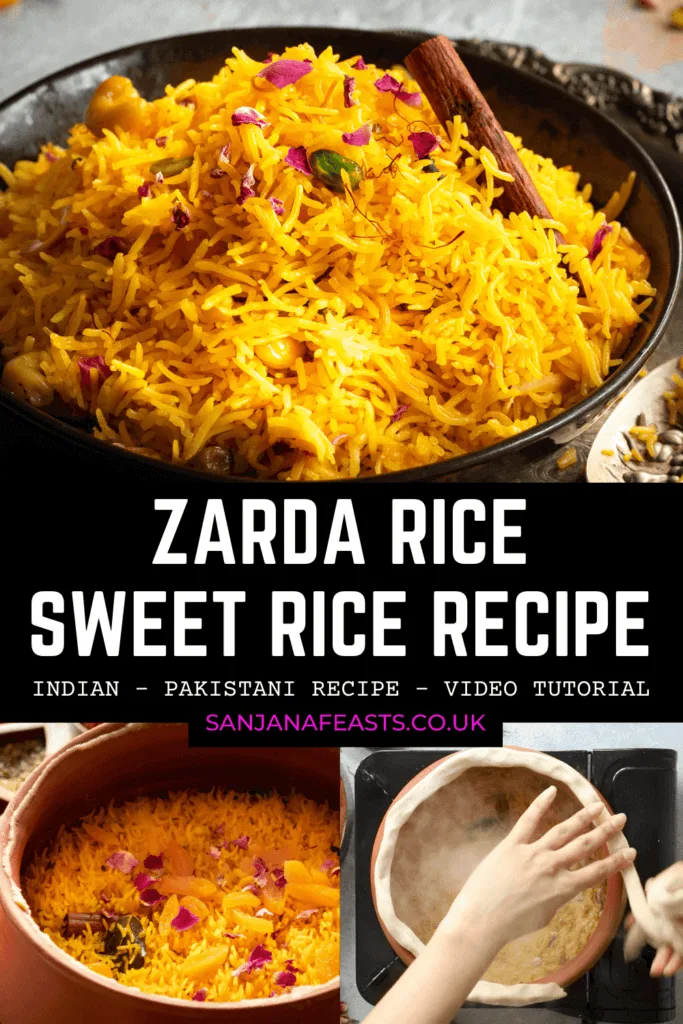
If you like this, you’ll love these other South Asian desserts
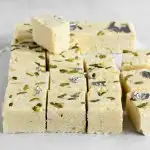
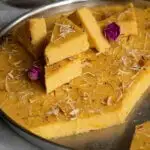
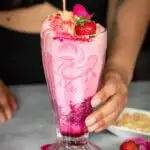
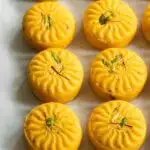
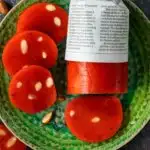


Love Sanjana

